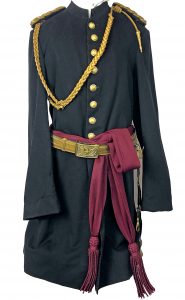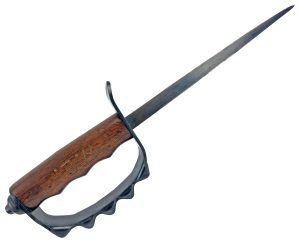Bidders Battle Over Collectible Militaria

On May 18, our country celebrated Armed Forces Day – this is a day we come together and thank our military for their patriotic services. Under the leadership of President Harry S. Truman, the holiday was first celebrated in May 1950 to unify all the armed forces under one agency – the Department of Defense. May is also Military Appreciation Month, and of course, our country will celebrate Memorial Day on Monday, May 27.
The heroic and horrific stories of past wars continue to be told through the relics, artifacts, documents, firearms, equipment and other militaria that have survived through time. Some serious collectors will pay top dollar for rare items, as evidenced by the sale of a U.S. flag that sold at auction in 2016 for $514,000. The flag flew from a control boat on D-Day and sold at Heritage Auctions in Dallas for five times the pre-auction estimate.

We see militaria from many different countries come through our auction house, and collectors will often battle in bidding frenzies to win a coveted piece of history. Earlier this month, we had a specialty auction on a Friday night that focused on militaria, western and Native American collectibles. The collection belonged to one man who was a big fan of General Custer and he took great care of his collectibles, which included Civil War uniforms, swords, a circa 1880 U.S. Cavalry dress helmet and more.
Bidding for the military collectibles was strong both live at the auction house and online. The star of the auction was a Plains Indian beaded deer hide war shirt, which hammered at $1,800. While a Native American collectible, it was worn by a warrior, and appealed to militaria collectors as well.
Other items that did well included a Civil War Union nine-button frock coat that realized $750, a U.S. Military circa 1860 Cavalry saber with scabbard that realized $550, a 1917 World War I U.S. American Cutlery Co. trench knife that sold for $475, and a Civil War Illinois Infantry ladder badge that sold for $250.
When it comes to assessing value of militaria, rarity, condition and provenance play an important role. As with any collectible, do your research to make sure you are not purchasing a fake or reproduction. There are many reproductions made for re-enactment groups that look authentic. But a closer look may reveal differences in materials, stitching, insignias, and other flaws that rule the item out as being original.

If you’re fortunate enough to collect direct from a veteran, ask him or her to share their story and then search through national archives and history books to learn about the battles they participated in. If an item is referred to as a “vet pickup,” it usually means the item was taken away from the original owner – in most cases from the enemy. Militaria from past enemies, such Germany and Japan, are in strong demand as well.
While some collectibles lose value over time or are cyclical, I believe there will always be a strong interest in collecting militaria. Not only is the history fascinating, there’s tremendous respect for the men and women who served their countries with courage and honor.
Auction House
EJ'S Auction & Appraisal- 0
- Bookmark

African-American Fine Art: April 2020 Highlights
From the postwar period, a top lot bound to garner attention is an untitled mixed-paper collage...

Copley’s $3.4 Million Winter Sale Is One For The Record Books
CHARLESTON, SC – Copley Fine Art Auctions, LLC, the nation’s premier decoy and sporting art auction house...

Disputing the Origins of Four-Legged Treasures
New York and Boston butt heads over more than sports teams: Try 18th-century walnut chairs whose...

